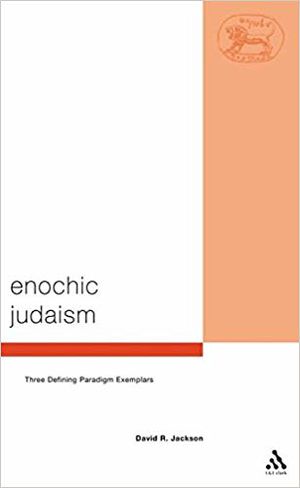Difference between revisions of "Enochic Judaism (2004 Jackson), book"
| (14 intermediate revisions by the same user not shown) | |||
| Line 1: | Line 1: | ||
[[File:2004 Jackson.jpg|thumb|300px]] | |||
'''Enochic Judaism: Three Defining Paradigm Exemplars''' (2004) is a book by [[David R. Jackson]]. | '''Enochic Judaism: Three Defining Paradigm Exemplars''' (2004) is a book by [[David R. Jackson]]. | ||
==Abstract== | ==Abstract== | ||
==Editions | "From the Books of Enoch, Jackson identifies a paradigm of order as opposed to deviation, which defined orthodoxy and elect identity in a manner which was absolutely exclusive. Over 300 years "Enochic Judaism" developed three working models within this paradigm to explain their worldview and its implications. These three models concerned 1) the fall of the angels under Shemikhazah (ethnic purity); 2) the revealing of secrets under the leadership of Aza'el (cultural purity); and 3) the going astray of the cosmos through the sin of the angels who govern its phenomena (liturgical purity). Jackson examines the way in which this tradition was developed within the Dead Sea Scrolls literature and notes its acceptance as authentic and authoritative within the so-called sectarian literature in particular."--Publisher description. | ||
==Editions== | |||
Published in London [England]: T&T Clark International, 2004 ([[Library of Second Temple Studies]], 49). | Published in London [England]: T&T Clark International, 2004 ([[Library of Second Temple Studies]], 49). | ||
| Line 11: | Line 15: | ||
[[Category:2004| Jackson]] | [[Category:2004| Jackson]] | ||
[[Category: | [[Category:English language--2000s|2004 Jackson]] | ||
[[Category: | [[Category:Enochic Studies--2000s|2004 Jackson]] | ||
[[Category: | [[Category:Enochic Studies--English|2004 Jackson]] | ||
[[Category: | [[Category:Enochic Judaism (subject)|2004 Jackson]] | ||
Latest revision as of 01:30, 25 July 2018
Enochic Judaism: Three Defining Paradigm Exemplars (2004) is a book by David R. Jackson.
Abstract
"From the Books of Enoch, Jackson identifies a paradigm of order as opposed to deviation, which defined orthodoxy and elect identity in a manner which was absolutely exclusive. Over 300 years "Enochic Judaism" developed three working models within this paradigm to explain their worldview and its implications. These three models concerned 1) the fall of the angels under Shemikhazah (ethnic purity); 2) the revealing of secrets under the leadership of Aza'el (cultural purity); and 3) the going astray of the cosmos through the sin of the angels who govern its phenomena (liturgical purity). Jackson examines the way in which this tradition was developed within the Dead Sea Scrolls literature and notes its acceptance as authentic and authoritative within the so-called sectarian literature in particular."--Publisher description.
Editions
Published in London [England]: T&T Clark International, 2004 (Library of Second Temple Studies, 49).
